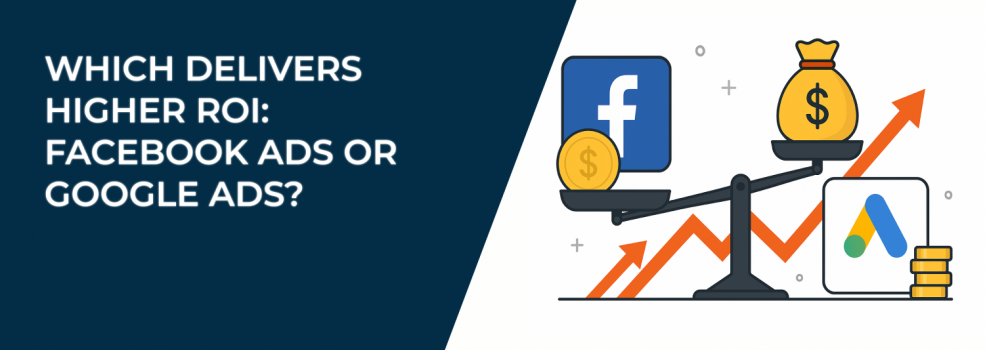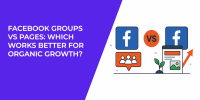You’ve got a limited budget, a performance goal to hit, and pressure to show results fast.
But you’re stuck at a familiar crossroads: should you put your money into Facebook Ads or Google Ads?
This question comes up constantly for marketers, agencies, and business owners alike — especially when early test campaigns don’t perform as expected. You’ve probably seen metrics that look fine on paper, but the leads don’t convert. Or worse, your ad costs keep rising without any clear reason.
You may be wondering:
-
“Why are my Google clicks so expensive?”
-
“Why isn’t my Facebook ad converting, even though the creative is strong?”
-
“Which one actually brings me sales — not just traffic?”
This article won’t offer a one-size-fits-all answer — because there isn’t one.
But it will help you make a smarter, more informed decision based on how these platforms actually work, how they impact ROI, and how you can align them with your specific business goals.
The Real ROI Question
Before comparing platforms, let’s clarify what ROI in digital advertising really means.
ROI = (Revenue from ads – Cost of ads) ÷ Cost of ads × 100
But this formula doesn’t tell the full story.
Real ROI considers how well your ad spend contributes to revenue in your sales context. A $3 click isn’t expensive if it brings a customer who stays for years. A $0.50 click is a waste if that person bounces instantly and never returns.
The best campaigns don’t focus only on getting clicks — they focus on getting profitable conversions.
Facebook Ads: Strong ROI When You Build Demand Strategically
Facebook Ads (including Instagram placements) are designed for audience discovery. You’re not showing up in response to a search — you’re putting your offer in front of people based on their interests, behaviors, and similarities to your existing customers.
That makes Facebook powerful for:
-
Brand introduction, especially when your offer needs emotional context or explanation.
-
Visual selling, using images, video, or dynamic creatives to stand out in the feed.
-
Full-funnel campaigns, from awareness to retargeting and conversion.
-
Products or services with broad lifestyle appeal, like fitness, fashion, education, or wellness.
To make Facebook campaigns work, your targeting needs to be tight — not just broad interests. If you haven’t clearly defined your audience yet, this step-by-step guide to defining a target audience is a solid place to start.
Even experienced advertisers run into technical issues. If you’ve seen the “ad set may get zero” error, it likely means your targeting is too narrow or your optimization goal is mismatched. This article explains how to fix the ‘ad set may get zero’ warning and ensure your ads actually deliver.
Google Ads: Strong ROI When You Capture Intent Precisely
Google Ads are built around user intent. Someone types in a search query — your ad shows up to answer it. If that search is tied to a purchase decision, this can lead to very efficient conversions.
Google Ads are especially effective for:
-
High-intent transactional keywords, where the buyer is already in research or purchase mode.
-
Service-based industries, where people need a quick solution (e.g. plumbing, legal advice, urgent care).
-
Products with clear comparison criteria, such as SaaS tools or consumer electronics.
-
Capturing demand that already exists, instead of creating new interest.
Because Google is keyword-based, your ability to write strong ads and match them to relevant landing pages is essential. Without that alignment, even the best search volume won’t translate to results.
Key Differences That Affect ROI
Choosing between Facebook and Google Ads isn’t about which platform is “better.” It’s about which one fits your product, your audience, and your funnel.
Here’s how to evaluate:
1. Buying Intent
-
Google: Reaches people who are actively looking for something.
-
Facebook: Reaches people who might be open to discovering something new.
2. Funnel Stage
-
Google: Works well at the bottom of the funnel.
-
Facebook: Can support all funnel stages, especially top and middle.
3. Creative Control
-
Facebook: Offers flexibility with visuals, copy, and formats.
-
Google: Offers less flexibility on Search, but more on Display and YouTube.
4. Sales Cycle Length
-
Facebook: Better suited for longer or more complex sales cycles.
-
Google: Ideal for direct, fast conversions with clear intent.
5. Optimization Strategy
-
Facebook: Success often hinges on audience structure and creative testing.
-
Google: Keyword strategy, bidding models, and landing page quality carry more weight.
If your Facebook Ads aren’t performing and you’re not sure why, this guide to fixing Facebook Ads that don’t convert will help you diagnose the weak spots and adjust without starting from scratch.
And if you’re struggling to pick the right Facebook campaign type for your objective — whether it's traffic, leads, or purchases — this breakdown of Meta ad campaign objectives walks through each option in plain terms.
What About Ad Costs?
Facebook typically offers lower cost-per-click (CPC), but Google clicks often carry higher intent — and that can lead to a better conversion rate.
That said, cost alone doesn’t equal value.
Focus on your cost per acquisition (CPA), and how it compares to average order value (AOV) or customer lifetime value (LTV). A campaign that costs more upfront but produces long-term customers often delivers better ROI than a cheaper one with low-quality leads.
If you're optimizing for efficiency, always evaluate ROI in the context of how your business earns revenue — not just how much you're paying per click.
Use Both Platforms — But With Clear Roles
Advertisers who rely solely on one platform often leave revenue and growth potential untapped. The strongest strategies assign a specific purpose to each platform.
Here’s a framework that works:
-
Use Google Ads to capture bottom-of-funnel traffic — people searching with intent.
-
Use Facebook Ads to introduce your offer to new audiences and retarget those who didn’t convert.
-
Build lookalike audiences on Facebook using the data from your Google-converted leads.
-
Run educational or nurturing content on Facebook, especially for high-ticket or long-cycle products.
-
Test hooks and creatives on Facebook, then bring winning messaging into Google Display or YouTube formats.
When both platforms work together, you get more consistent results across the funnel.
What Should You Do Next?
If you’re trying to improve ROI but not sure where to start, here’s a straightforward plan:
-
Evaluate your funnel.
-
Are people searching for what you offer? Start with Google Ads.
-
Are you introducing something unfamiliar or visual? Lead with Facebook Ads.
-
-
Define a clear role for each platform.
-
Don’t run identical campaigns on both. Assign a job — awareness, retargeting, lead gen — to each one.
-
-
Fix the weak links first.
-
If your Facebook Ads are running but not converting, review your creative, audience, and campaign objective.
-
If your Google Ads are burning budget, revisit your keyword strategy and ad relevance.
-
-
Track beyond clicks.
-
Set up proper conversion tracking. Know which clicks turn into real leads or customers — and which don’t.
-
-
Scale what works. Cut what doesn’t.
-
If one campaign performs better, increase spend incrementally while maintaining efficiency.
-
If something’s clearly underperforming, pause and reassess. Don’t try to “spend your way out.”
-
Once you’ve worked through this plan, start testing on a small scale and use real performance data to guide your budget shifts rather than assumptions. Over time, this disciplined approach will show you exactly which platform delivers the best ROI for your specific business.

